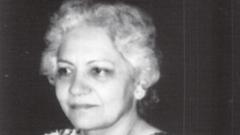

Dr. Sneh Bhargava, AIIMS' first woman director, and Dr. P. Venugopal, who performed India's first heart transplant, both recall the tragic day of Indira Gandhi's assassination on October 31, 1984, as a pivotal moment. Their accounts offer a glimpse into the chaotic scene at the All India Institute of Medical Sciences (AIIMS) in New Delhi and the desperate attempts to save the Prime Minister's life.
Dr. Bhargava was in the radiology department, discussing a case with students when a radiographer informed her that Indira Gandhi had been brought to the casualty ward. Surprised by the lack of prior announcement, she immediately sensed something was wrong. She rushed to the casualty and saw Indira Gandhi on a trolley, without a sheet, soaked in blood. Dr. Bhargava could only recognize her by the streak of grey hair. Sonia Gandhi, Indira Gandhi's daughter-in-law, arrived at AIIMS and could only utter, "She has been shot…," and was having an asthmatic attack.
Dr. Venugopal's day began like any other until a junior doctor rushed in to tell him that Mrs. Gandhi had been admitted to the casualty ward. He sprinted to the scene, finding chaos with AIIMS personnel and Indira Gandhi's aides, M. L. Fotedar and R. K. Dhawan, in distress. He saw Indira Gandhi's slender figure on the bed, drenched in blood, her face pale. Doctors were attempting to transfuse O-negative blood, but it seemed futile. Dr. Venugopal ordered her to be taken to the operation theatre immediately to stop the profuse bleeding. He did not wait for the signed consent form due to the urgency.
In the operation theatre, Dr. Venugopal planned to use a bypass machine and clamp the descending aorta to prevent blood flow to the abdomen, which was riddled with bullets. As her sari was removed, bullets fell all over the floor. It was later discovered that 30 of the 33 bullets fired had hit her. Dr. Venugopal believes that if Indira Gandhi had been covered or dragged to safety after the initial shots, she might have survived. He maintains that she appeared to have fallen after the first bullet, and her companions had retreated, leaving her vulnerable.
Dr. Bhargava focused on shifting Indira Gandhi's body to a secure location, anticipating a large crowd at AIIMS. She, along with a consultant and two other doctors, moved her to an operation theatre on the eighth floor, while informing people that doctors were trying to save her. She disclosed that President Giani Zail Singh was in Yemen, and Rajiv Gandhi was campaigning in North East India. The Health Minister, Shankaranand, instructed them not to declare her dead until Rajiv's arrival.
Dr. Venugopal and his team worked for four hours, changing their blood-soaked OT clothes thrice. Around 2 pm, they tried to take her off the bypass but were unable to revive her. The hospital room became a hub of discussion regarding the swearing-in of the next Prime Minister. The consensus was to wait for Rajiv Gandhi's return.
Dr. Bhargava also faced the challenge of ensuring the safety of Sikh employees at AIIMS, fearing backlash after the assassination by Indira Gandhi's Sikh bodyguards. She offered them shelter at her residence within the AIIMS campus.
Dr. K.P. Mathur, Indira Gandhi's personal physician for 18 years, also recounted the events of that day. He had left her residence after a routine check-up and was called back urgently after she had been shot.